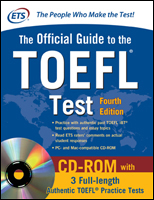About TOEFL
The purpose of the TOEFL (Test of English as a Foreign Language) test is to evaluate the English proficiency of people whose native language is not English. In 1998-99, more than 300,000 people registered to take the computer-based TOEFL test. The scores are required for purposes of admission by more than 4000 colleges and universities in Europe, the United States, and Canada. TOEFL is also used by institutions in other countries where English is the language of instruction. In addition, government agencies, scholarship programs, licensing/certification agencies, multinational companies (banks, insurance companies, accountancy companies) use TOEFL scores to evaluate English proficiency. Until 1998, the TOEFL was available throughout the world as a paper-based test. In July 1998 ETS introduced the computer-based TOEFL in the US, Canada, Latin America, Europe, the Middle East, Africa, and selected Asian countries. The TOEFL is now administered only as a computer-based test in these countries. More countries will be phased in over a three-year period. Once the computer-based test is introduced in a country, the paper-based test will no longer be available. According to ETS, the computer-based test will completely replace the paper test by 2001. In 2006, the TOEFL iBT (Internet-based test) was introduced replacing the TOEFL CBT. The structure and scoring system of the current TOEFL iBT is outlined below.
The TOEFL consists of 4 sections:
- Listening
- Reading comprehension
- Writing (2 compositions)
- Speaking
| Test Portion | Number of Questions | Time Limit |
| Tutorials | tutorials | Untimed |
| Listening | 30-50 | 60-90 minutes |
| Reading comprehension | 44-55 | 60-100 minutes |
| Writing | 2 topics | 50 minutes |
| Speaking | 6 tasks | 20 minutes |
Total time of the test is 4 hours
Scoring
Each of the four sections is marked out of a maximum of 30 points. Therefore, the total overall score is out of 120. A respectable score is more than 90/120 though many of the more competitive universities expect scores of at least 105/120.






